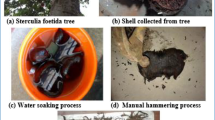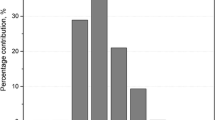Abstract
This study aims to obtain pebble and epoxy composites with low thermal conductivity, low water absorption and minimal porosity. The effects of filler size, weight percentage of pebble and epoxy, aggregate size and curing time of the composites were evaluated. The ANOVA of S/N ratio was also performed to determine the effect of thermal conductivity, water absorption and porosity of the composites. The experiments were designed as per the Taguchi L27 orthogonal array. The results indicated that the effect of thermal conductivity improved slightly with 35% (wt) of epoxy resin present in the composite and the higher thermal conductivity was observed in the composite with 15% (wt) of epoxy resin. Water absorption and porosity results were found which showed that this composite with 15% (wt) epoxy resin content yielded better results when compared to the composite with 35% (wt) epoxy resin content. The embedded composites were characterized using Fourier transform infrared (FTIR) spectra to study the effect of chemical treatment of pebble/epoxy composite. The morphological studies of the fractured surfaces of the epoxy composites were performed by scanning electron microscopy.





Similar content being viewed by others
References
Do Suh J, Kim HS, Kim JM (2004) Design and manufacture of composite high speed machine tool structures. Compos Sci Technol 64:1523–1530
Badiea AM, Mohammed BG, Firas AA (2016) Glass–polymer–concrete composite and its mechanical, chemical and thermal properties. Appl Sci Technol 16:1–8
Yongjin FE, Feng K, Liu Y, Gong B, Cheng Y (2015) Experimental investigation of thermal properties of the li4sio4 pebble beds. Plasma Fusion Res 11:49–52
Asiltürk I, Neşeli S, Ince MA (2016) Optimisation of parameters affecting surface roughness of Co28Cr6Mo medical material during CNC lathe machining by using the Taguchi and RMS methods. Measurement 78:120–128
Kim HS, Park KY (1995) A study on the epoxy concrete for the ultra—precision machine tool bed. J Mater Process Technol 48:649–655
Rahman M, Mansur MA, Lee LK, Lum JK (2001) Development of a polymer impregnated concrete damping carriage for linear guide ways for machine tools. Int J Mach Tools Manuf 41:431–444
Piratelli-Filho A, Levy-Neto F (2010) Behaviour of granite epoxy beams subjected to mechanical vibrations. Mater Res 13:497–503
Suh JD, Lee DG (2008) Design and manufacture of hybrid polymer concrete bed for high-speed CNC milling machine. Int J Mech Mater Des 4:113–121
Bruni C, Forcellese A, Gabrielli F, Simoncini M (2008) Hard turning of an alloy steel on a machine tool with a polymer concrete bed. J Mater Process Technol 202:493–499
Selvakumar A, Mohanram PV (2013) Analysis of effective thermal conductivity for mineral cast material structures with varying epoxy content using tps method. Mater Res 16:315–321
Al-Ajlan SA (2006) Measurement of thermal properties of insulation materials by using transient plane source technique. Appl Therm Eng 26:2184–2191
Bentz DP, Peltz MA, Duran Herrera A, Valdez P, Juarez CA (2011) Thermal properties of high volume flyash mortars and concretes. J Build phys 34:263–275
Bentz DP (2007) Transient plane source measurements of the thermal properties of hydrating cement pastes. Mater Struct 40:1073–1080
Cote J, Konrad JM (2009) Assessment of structure effects on the thermal conductivity of two-phase porous geomaterials. Int J Heat Mass Transf 52:796–804
Tzeng CJ, Lin YH, Yang YK, Jeng MC (2009) Optimization of turning operations with multiple performance characteristics using the Taguchi method and grey relational analysis. J Mater Process Technol 209:2753–2759
Kamath S, D’mello J, Balakrishna SS (2014) Experimental study on mechanical properties of red granite epoxy particulate composites. Int J Mech Eng Robot Res 3:178–187
Ramakrishna HV, Rai SK (2006) Effect on the mechanical properties and water absorption of granite powder composites on toughening epoxy with unsaturated polyester and unsaturated polyester with epoxy resin. J Reinf Plast Compos 25:17–32
Pawar MJ, Patnaik A, Nagar R (2017) Experimental investigation and numerical simulation of granite powder filled polymer composites for wind turbine blade: a comparative analysis. Polym Compos 38:1335–1352
Zhu H, Wu B, Li D, Zhang D, Chen Y (2011) Influence of voids on the tensile performance of carbon/epoxy fabric laminates. J Mater Sci Technol 27:69–73
Lotfian S, Giraudmaillet C, Yoosefinejad A, Thakur VK, Nezhad HY (2018) Electrospun piezoelectric polymer nanofiber layers for enabling in situ measurement in high-performance composite laminates. ACS Omega 3:8891–8902
Nezhad HY, Thakur VK (2018) Effect of morphological changes due to increasing carbon nanoparticles content on the quasi-static mechanical response of epoxy resin. Polymers 10:1106
An D, Lotfian S, Mesbah D, Ayre D, Yoosefinejad A, Thakur VK, Nezhad HY (2019) Ultra-thin electrospunnanofibers for development of damage-tolerant composite laminates. Mater Today Chem 14:100202
Mgbemena CO, Li D, Lin MF, Liddel PD, Katnam KB, Thakur VK, Nezhad HY (2018) Accelerated microwave curing of fibre-reinforced thermoset polymer composites for structural applications: a review of scientific challenges. Compos Part A Appl Sci Manuf 115:88–103
Nkwanyana S, Loveday B (2017) Addition of pebbles to a ball-mill to improve grinding efficiency. Miner Eng 103–104:72–77
Shantry K (2020) The selection of boiling stones from a heterogeneous supply. J Archaeol Sci Rep 29:102030
Mawire A, McPherson M, Van den Heetkamp RR, Mlatho SJ (2009) Simulated performance of storage materials for pebble bed thermal energy storage (TES) systems. Appl Energy 86:1246–1252
Dinesh N, Karuppaiya A (2017) Experimental study on strength of concrete using crushed pebbles by replacement of fine aggregate. Int Res J Eng Technol 4:1507–1511
Vaishali P, Dhanalakshmi G (2018) Effect of manufactured sand on mechanical properties of concrete. Int Res J Eng Technol 5:1646–1649
Rout AK, Satapathy A (2013) Study on mechanical and erosion wear performance of granite filled glass–epoxy hybrid composites. J Mater Des App 229:38–50
Patnaik PK, Swain PT, Biswas S (2018) Investigation of mechanical and abrasive wear behavior of blast furnace slag-filled needle-punched nonwoven viscose fabric epoxy hybrid composites. Polym Compos 2:1–11
Ramya devi G, Palanikumar K (2019) Analysis on drilling of woven glass fibre reinforced aluminium sandwich laminates. J Mater Res Technol 8:1024–1035
Paraskar P, Bari P, Mishra S (2020) Influence of amine functionalized graphene oxide on mechanical and thermal properties of epoxy matrix composites. Iran Polym J 29:47–55
Dinesh S, Kumaran P, Mohanamurugan S, Vijay R, Singaravelu DL, Vinod A, Sanjay MR, Siengchin S, Bhat KS (2020) Influence of wood dust fillers on the mechanical, thermal, water absorption and biodegradation characteristics of jute fiber epoxy composites. J Polym Res 27:9
Delgado E, Espitia A, Aperador W (2020) Comparative evaluation of Clusia multiflora wood flour, against mineral fillers, as reinforcement in SBR rubber composites. Iran Polym J 29:13–23
Liu C, Sun M, Zhang B, Zhang X, Xue G, Zhang X (2020) Curing kinetics, thermal and adhesive properties of phthalonitrile/aromatic diamine systems. Iran Polym J 29:67–75
Hu L, Pu Z, Zhong Y, Liu L, Cheng J, Zhong J (2020) Effect of different carboxylic acid group contents on microstructure and properties of waterborne polyurethane dispersions. J Polym Res 27:1–9
Bunekar N, Tsai TY, Huang HP (2018) Effect of functionalized graphene with modified clay on flammability of copper clad laminated novolac cured epoxy composites. Polym Plast Technol Mater 58:547–559
Author information
Authors and Affiliations
Corresponding author
Rights and permissions
About this article
Cite this article
Murugan, S., Thyla, P.R., Mahendrakumar, N. et al. Thermal and environmental analyses of epoxy-based composites. Iran Polym J 30, 93–103 (2021). https://doi.org/10.1007/s13726-020-00876-8
Received:
Accepted:
Published:
Issue Date:
DOI: https://doi.org/10.1007/s13726-020-00876-8




